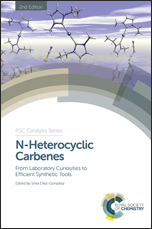"NHC-Iron, Ruthenium and Osmium Complexes in Catalysis"
Lionel Delaude and Albert Demonceau
 |
title: N-Heterocyclic Carbenes:
From Laboratories Curiosities to Efficient Synthetic Tools,
2nd Edition
series: RSC Catalysis Series
editor: Silvia Díez-González
series editor: James J. Spivey
publisher: The Royal Society of Chemistry
city: Cambridge
year: 2017
volume: 27
first page: 268
last page: 301
isbn: 978-1-78262-423-3
doi: 10.1039/9781782626817-00268
|
Abstract: In this Chapter, the catalytic applications of organometallic species -either preformed or generated in situ- based on Group 8 transition metals and N-heterocyclic carbene (NHC) ligands are surveyed. Although the coordination chemistry of iron with NHCs was first explored in the 1970s, the use of NHC-Fe complexes in catalysis did not start until the new millennium and is still in its infancy. Significant developments reported thus far concern mainly polymerisation, cyclisation, coupling, or reduction reactions. Other important transformations mediated by NHC-Fe species have been reported in organometallic synthesis and biocatalysis. Contrastingly, the chemistry of NHC-Ru complexes has reached an unprecedented level of maturity, thanks to the relentless research efforts thrown into the development of olefin metathesis catalysts. Other carbon skeletal transformations based on NHC-Ru promoters include cyclopropanation, allylation, or cycloisomerisation reactions. Some of them were carried out in tandem with olefin metathesis. Lastly, with only a handful of reports to date concerning olefin metathesis and hydrogen transfer reactions, NHC-Os-based catalysis can hardly be considered anything else than a curiosity.
[Full Text] [<< Previous Book Chapter] [Back to the List of Publications] [Next Book Chapter >>] l.delaude@ulg.ac.be